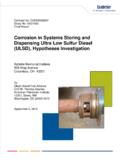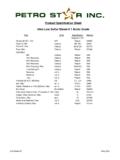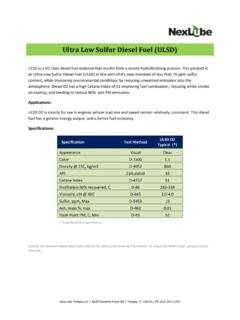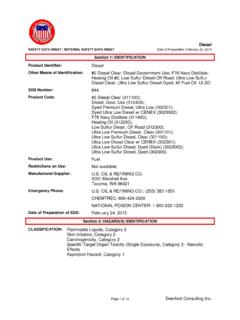Transcription of Local Law 77: DDC Ultra-Low Sulfur Diesel Manual
1 Prepared for NYC Department of Design & Construction Bradley & Associates, Inc. &Gruzen Samton LLPJune 2004 City of New YorDepartment of Design and Constructionk Local law 77: ddc Ultra-Low Sulfur Diesel manualHonorable Michael R. Bloomberg, MayorCity of New YorkDavid Burney, AIA, CommissionerNYC Department of Design and ConstructionDDC Architecture and Engineering Division:David Resnick, AIA, Associate CommissionerMargot A. Woolley, AIA, Assistant CommissionerJohn Krieble, RA, Director, Office of Sustainable DesignLaurie Kerr, RA, Office of Sustainable Designexecutive acknowledgementsThis document is an introduction and resource handbook for understanding New York City Local Law 77. This law requires the use of Ultra-Low Sulfur Diesel fuel (ULSD) and best available technology (BAT) for reducing emissions form non-road equipment used on City construction projects. The handbook is addressed to all the participants in the projects for the New York City Department of Design and Construction (DDC), but especially the administrators and managers from DDC, construction managers and contractors.
2 Its goal is to assist these professionals to understand and meet the requirements of NYC Local Law 77. table of contents1 executive summary12overview3 Current Situation Environmental and Health Impacts What Can Be Done Regulatory Climate Relevance to DDC How To Use This Document3summary of Local law 77134explanation of best available technology concept155technologies for reducing Diesel emissions17 Engine Modifi cations After-treatment Technologies6alternative fuels for reducing Diesel emissions237precedents & pilot projects278implementation issues299responsibilities of ddc administrators & project managers3310appendices37 A Acronym List B Text of NYC Local Law 77 C Diesel Fuel: Discussion & Specifi cations D Reasonably Available Control Technology for Generatorsitable of contents | ddc low Sulfur fuel manualiitable of contents | ddc low Sulfur fuel manual1executivesummary1executive summary | ddc low Sulfur fuel manualexecutive summaryIt has become increasingly clear that Diesel ex-haust is a serious air pollutant, causing signifi -cant adverse health effects nation-wide, but par-ticularly in dense urban areas.
3 According to New York City s Local Law 77, these health effects include an increased risk of decreased lung function, aggravated asthma, respiratory symptoms, and premature death. Much of this pollution comes from cars and trucks, but a sig-nifi cant and growing proportion is emitted by non-road sources, including construction equip-ment. While new vehicle and fuel standards for on-road cars and trucks have become more stringent in recent years, standards for non-road equipment have lagged. Consequently, non-road sources are becoming a more important contributor to over-all vehicle emissions. In response, New York City has recently passed legislation, Local Law 77, that requires the use of ultra low Sulfur Diesel fuel (ULSD) and best available technology (BAT) for reducing emissions from non-road equipment used on City construction projects. This legislation was specifi cally introduced to off-set increased emissions from the signifi cant construction activity that will take place around the World Trade Center site over the next few years, and initially applies only to projects in lower Manhattan.
4 Start-ing in 2004, however, these requirements will be phased in to all City construction projects city-wide. Consequently, this law will have an impact on many DDC projects in the very near future. In addition, the US Environmental Protection Agency recently passed strict new emission regulations for both on- and non-road Diesel vehicles and equipment in an effort to improve air quality in the United States. The focus of these new regulations, which take effect between 2006 and 2010, is the reduction of oxides of nitrogen (NOx), a smog forming ozone pre-cursor, and the reduction of particulate matter (PM) emissions that impair visibility and damage the health of individuals, particularly construction workers, children and the elderly. To facilitate these new emission control levels the EPA is also requiring the use of ULSD, with a Sulfur content no greater than 15-ppm, beginning in June 2006 for on-road vehicles and June 2010 for non-road vehicles and engines.
5 Current (2004) EPA regulated on-road Diesel fuel is al-lowed to have up to 500-ppm Sulfur and off-road Diesel fuel is allowed to have up to 3,000-ppm the new fuel rules will apply to all vehicles, the EPA vehicle regulations only apply to new Diesel vehicles and engines. Given the signifi cant inventory of existing Diesel vehicles in use and their propen-sity for long life, the full benefi ts of the new EPA regulations will be delayed for several decades. It is in this context that New York City passed Local Law 77. This law mandates early use of cleaner ULSD as well as engine and retrofi t technologies that have been developed to meet the more stringent future EPA mandates. Without the new EPA rules in place, it is unlikely that the requirements of Local Law 77 could be enacted because appropriate fuels and emissions reduction technologies would not be available. But without Local Law 77 it would be many years before most of the Diesel construction equipment used in NYC would be signifi cantly cleaned up.
6 This requirement to use ULSD and BAT applies to all city-owned non-road Diesel vehicles and engines, as well as any privately-owned Diesel vehicles and engines used on construction projects funded by the City. In order to comply with this new law, the DDC is writing this requirement into its General Condi-tions for future DDC sponsored projects, and will be required to monitor Contractor compliance. Failure to comply will subject the Contractor to signifi cant civilian fi nes, which will be assessed by the New York City Department of Environmental summary | ddc low Sulfur fuel manualThe requirements of Local Law 77 will have a modest impact on construction costs. The current price per gallon for ULSD can be expected to be about $ to $ per gallon higher than standard #1 on-highway Diesel fuel, due in part to the dedicated infrastructure necessary to prevent contamination. This price gap is expected to shrink to roughly 10 cents as ULSD becomes standard for all on-road vehicles after 2006.
7 The cost of BAT retrofi t is highly variable, ranging form $3,000 to over $20,000 for each piece of equipment, depending on the technology and the equipment size. The New York City Department of Environmental Protection is also required under the law to develop and publish regularly updated lists of BAT for various types of non-road vehicles and engines. While the requirement to use ULSD is already in effect, the BAT requirements will not take effect until DEP publishes the BAT lists, which will be posted on the DEP web site. Once BAT determinations have been made, DDC sponsored projects will be required to make sure that their projects comply with the requisite emission controls or BAT s, as they are updated by engine technology has changed signifi cantly over the last 20 years, and new engines delivered today, especially those used in on-road vehicles, are signifi cantly different that those in older vehicles. Many of these changes have reduced NOx and PM emissions signifi cantly compared to the older engines.
8 In gen-eral, there are three ways that emissions from Diesel engines can be reduced: 1) make changes to the design of the engine itself, 2) install an after-treatment device which does not affect the way the engine operates, but instead cleans up the exhaust after it has left the engine, and 3) use a non-standard alternative Diesel fuel which burns more cleanly in the existing Diesel engine. At this point in time, ULSD is considered to be a non-standard, cleaner Diesel fuel, but it is not the only one above three approaches to emissions reduction are not mutually exclusive. In fact, some after-treatment technologies work better with alternative Diesel fuels, or may even require the use of a non-standard fuel to be effective. Likewise, some fuels or after-treatment technologies may work better in combination with engine modifi cations. In addition, each fuel and technology option has a different cost, and some may pose signifi cant implementation challenges on particular engines or vehicles where space is at a premium.
9 These factors, combined with the sheer variety of Diesel equipment used on construction sites, make it a virtual certainty that DEP s lists of BAT will include a variety of options. It is highly unlikely that any one fuel and/or technology approach will be designated as the best available technology for all Diesel vehicles and engines used in construction activities in NYC. In fact, for some vehicle types DEP may determine that the use of ULSD by itself constitutes the best available technology. For other vehicle types, DEP may determine that some form of engine modifi cation, engine replacement, or after-treatment retrofi t will be required to bring the vehicle to the point that it incorporates the best available technology. For other vehicle types, DEP may determine that there is more than one equivalent option, and the BAT list may in-clude several alternatives to choose from. In this latter case, the alternatives may include the use of a non-standard fuel blend with ULSD, which provides even greater emissions reductions than ULSD by purpose of this report is to provide DDC Project Managers and City Contractors with information to help them implement Local Law 77 on NYC construction projects.
10 The report provides background infor-mation on Diesel engine emissions, health effects and regulations. It also includes information on ULSD and how it is different than standard Diesel fuel, plus a primer on all of the commercially available alterna-tive Diesel fuels and retrofi t technologies that are likely to appear as NYSDEP BAT. Finally, it provides spe-cifi c information about the responsibilities of DDC project managers in implementing Local Law 77, and information about real and perceived obstacles to implementation. Several DDC projects both Infrastruc-ture and Structure will serve as pilot projects to help DDC identify any diffi culties with | ddc low Sulfur fuel manualoverviewcurrent situationPrior to Local Law 77 the most common fuels used in New York City construction equipment have been Diesel fuels and kerosene. The (500-3000 ppm) Sulfur Diesel fuel category includes No. 1 Distillate, No. 2 Distillate, High- Sulfur Diesel and Low Sulfur Diesel (<500 ppm).
















